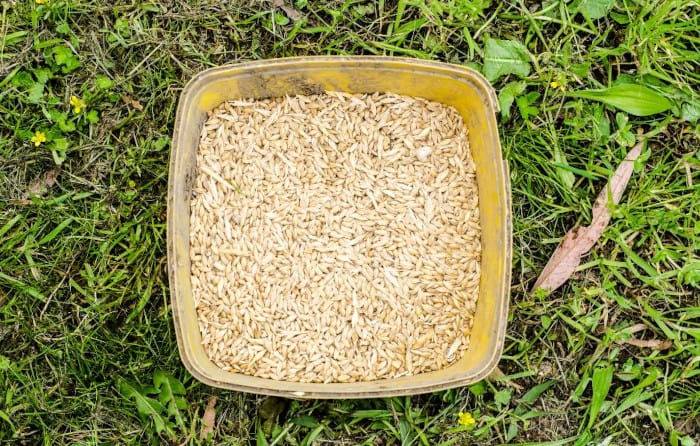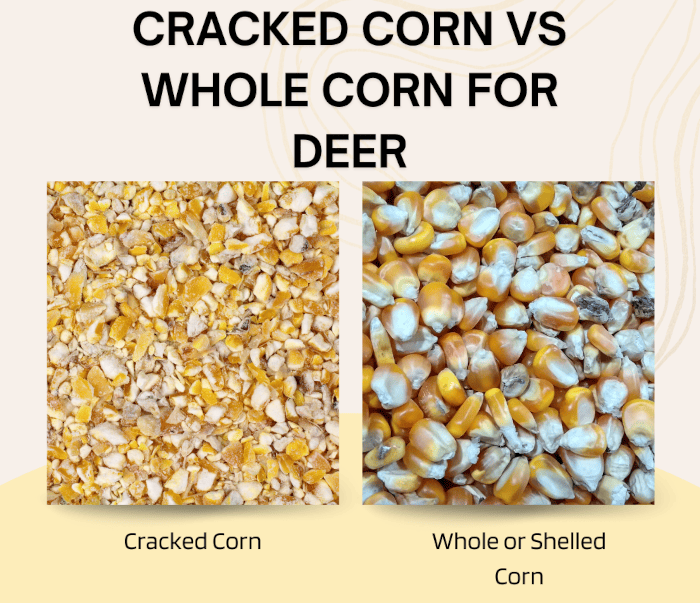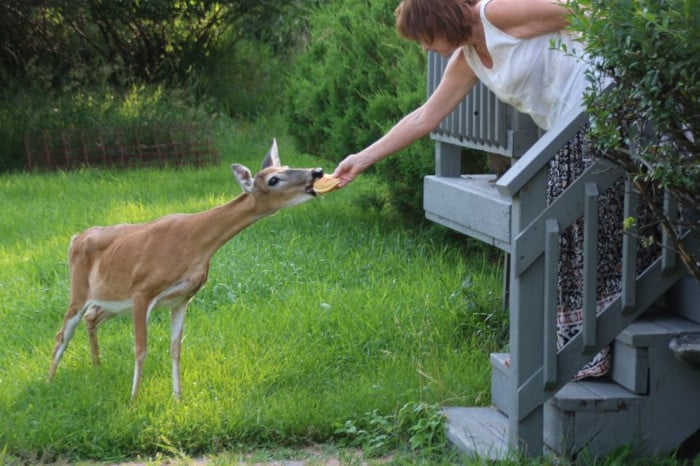If you’ve spent any time managing a deer feeder, then you are probably already aware of a deer feeder’s number one nemesis: the squirrel (or, in typical cases, a pack of squirrels).
Some experienced deer hunters might argue that a raccoon is the biggest problem they encounter with a deer feeder, but my money is on squirrels. Yes, I’ve seen a family of raccoons absolutely inhale all the corn from a feeder, but I haven’t found them to be as damaging and downright difficult to deal with as squirrels.
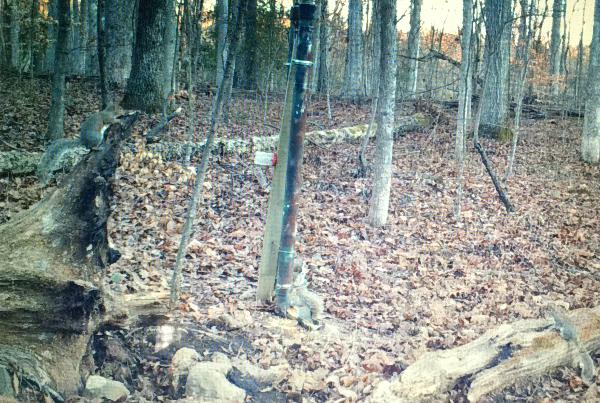
I’m absolutely convinced that a squirrel will eat as much corn or deer feed as they can get their greedy little paws on. But they also will carry as much off as they can to be buried or stored for later consumption.
But, in addition to eating all the corn, they are also known to do the following:
- Damage a feeder by chewing any exposed wiring
- Damage the feeder barrel or barrel where the feed is in an attempt to access more corn.
- Mess up the spreader on a broadcast feeder by pulling, biting, or trying to tear the feeder spinner off.
I’ve had feeders that were mauled by a black bear that ended up with less damage than what a pack of squirrels can do in one hunting season.
The issues that squirrels pose at a deer feeder are two-fold:
- They eat any corn or feed that comes from the feeder is meant for the deer
- They also will go to any lengths to get more food from the feeder than it usually dispenses.
How to Keep Squirrels Out of a Deer Feeder
Having owned, set up, and managed several deer feeders throughout my life so far, I have tried nearly everything, every trick, every suggestion that I could find about how to squirrel-proof a deer feeder. Some tips and tricks worked, while the squirrels quickly found workarounds for most.
I’m going to share what I’ve found to work best into two categories:
- Squirrel Proofing a Deer Feeder
- Alternative Ways to Deal with Squirrels
Let’s look at each topic in more detail:
How to Squirrel Proof a Deer Feeder
Understanding that there are several different styles of deer feeders on the market, I’m going to be focusing most of this content on what’s called tripod feeders (as in they are supported off the ground with three legs) or broadcast feeders (which is another name for a tripod feeder). I’m focusing on this style as it’s the most popular style for deer hunters and the most commonly used type.

These are the few techniques or devices that I’ve tried over the years that seemed to work with various level of success:
Electrical shock
The idea behind this concept is the squirrels that try to climb up the feeder legs will receive a mild electrical shock that deters them from trying to steal feed from the feeder. This approach has proven very successful for me but does come with some potential downsides, including:
- The shock is powered by the battery that runs the broadcaster, which can prematurely run the battery down.
- If a deer accidentally makes contact with a feeder leg, you most likely won’t ever see them again.
- The feeder legs have to be manufactured from metal.
Implementation of this approach can be tricky as you only have two potential options:
- Use an existing commercially made device that meets the need
- Rig something up yourself using the battery for the broadcast spinner or with another battery.
Commercially made solutions
As far as commercially made products, the only one I’m familiar with and have used personally is the American Hunter Varmint Zapper. Still, it’s only designed to work with compatible American Hunter feeder kits. However, I’ve found it to work very well.

Here are the best prices that I could locate for this product:
The only drawback, and I’ve mentioned this before, is that you will either have to replace or recharge the feeder battery more than usual.
Rigging up a shocking solution yourself
I spent some time trying to adapt the Varmint Zapper I mentioned above to work with other feeder units but never had any success. Of course, I’m not the most creative person, either.
I’ve tried building something similar myself but never had any real success. However, if you are handy with electricity, you may be able to make something that works.
Anti-Squirrel Tripod Leg Covers
Anti-squirrel leg covers are just some verbiage that I created to describe these types of covers that go over the legs of the feeder. This style of leg covers features aggressive barbs, spikes, tabs, etc., that are positioned in a manner that makes it painful for a squirrel (or raccoon for that matter) to climb the leg or legs of the feeder.

The best known of this style commercially is the Boss Buck Shark Teeth, which are 1 ½” strips of metal that feature very aggressive barbs on one side. When applied to a feeder’s leg, the barbs make it downright unpleasant to climb the leg, but the Shark Teeth can also be applied to other parts of the feeder to deter other varmints as well.
The nice thing about this product is that it will work on almost any feeder and is not just limited to the Boss Buck brand of feeders.
These can be effective in deterring squirrels from climbing the feeder to access the hopper, but you have to apply them in such a manner that a squirrel cannot jump over them while climbing the tripod legs. I usually run one set of these on two sides of each tripod leg all the way up the leg. I prefer to make sure that each leg is fully covered as that has provided the best results.
The Shark Teeth strips can also be applied to the top of the feeder and the sides to keep squirrels off the top of the feeder. This is especially helpful if your feeder is in a position where a squirrel can jump from a nearby tree onto the top of the feeder.
Another positive point with these strips is they also work well as a deterrent to keep larger animals like hogs, livestock, goats, etc., from rubbing up against the tripod legs.
Looking at reviews of these online, the results seem to be hit or miss, but I think they are most effective when you mount the strips in a manner where the tripod legs are completely covered, or at least as covered as possible.
Now, if you happen to be handy, you can also fabricate some of these as well from different materials. I’ve seen some really simple ones that were made by driving a bunch of roofing nails through a piece of aluminum and mounting that on a leg. Another option is carpet tack, as it’s already embedded with nails.
Again, I’m not that handy and find it easier just to purchase them outright.
Here are a few places where I found the best deals:
Anti-Squirrel Leg Funnels or Leg Blocks
These devices are somewhat self-explanatory as they are a wide O-shaped funnel designed to stop squirrels from climbing up the feeder legs to access the feed. These devices work by creating a barrier that the squirrels can’t climb around or over.
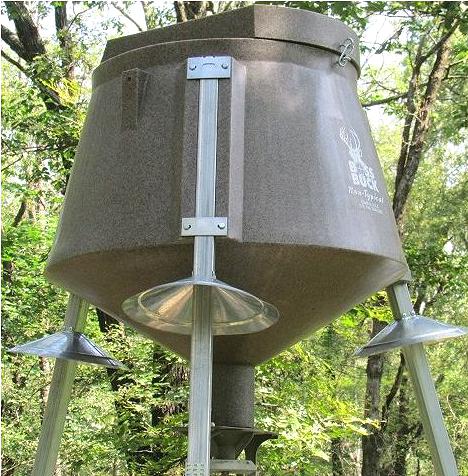
In addition to stopping the squirrels, funnels can also work well on raccoons. They don’t tend to work as well for bears.
These anti-squirrel funnels come in various sizes and shapes and are available in versions to work with most tripod feeders. Boss Buck offers their particular style of funnel in a 3 pack or 4 pack version.
The trick with funnels of this nature is to mount them high enough off the ground and high enough up the feeder leg so that a squirrel can’t jump over the funnel and use it as a landing pad to continue up the feeder legs.
I’ve found these to work best in situations where the feeder is placed on the edge of a field or in a location where the squirrels can’t use a nearby tree to bypass the legs to get onto the feeder.
Varmint Feeder Guards
Feeder guards are basically just a wire bucket designed to fit over the feeder spreader. The wire guard is large enough and strong enough to stop squirrels from being able to stick their paws into the feeder area and open enough to allow the feed to pass through as it comes out of the feeder.
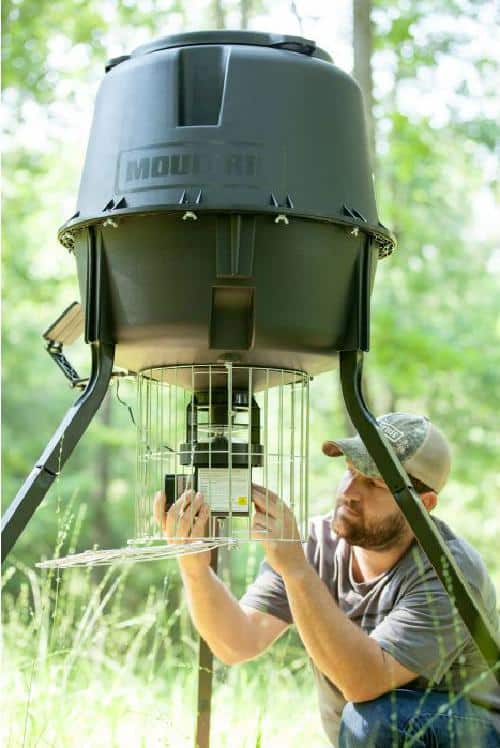
Personally, I’ve had so-so results with varmint guards. They are certainly better than no guard at all, but I’ve seen somewhere the squirrels had no trouble forcing a paw into the feeder to turn the broadcaster to have more corn thrown.
My biggest issue with varmint guards has been the following:
- The attachment points where the guard attaches to the feeder are not strong enough to support a larger animal’s weight like a big raccoon and ends up coming disconnected from the feeder.
- The guards are built so that the feed cannot properly exit with enough force to through it more than a foot or two from the feeder. Once this happens, all the feed piles up under the feeder, and the squirrels go to town.
- Most guards are built by a specific feeder brand and will only work with that particular feeder brand. For example, Moultrie makes a decent feeder guard, but it only works with Moultrie feeders.
Coat the Feeder Legs in Something Slick
This idea has been around forever, and it’s a pretty straightforward solution. Coat each of the feeder legs in a thick coat of something thick and greasy that will impede the squirrel’s ability to climb the feeder leg.
The two most popular materials seem to be Vaseline or Crisco shortening. Both are waterproof and stay on the legs for a decent amount of time.
I’ve only had so-so success with this approach. I’ve found both materials work about 50% of the time, but it does make for some trail cam humor watching them try to climb a slick pole.
I’ve found that you have to keep the legs absolutely slathered in the stuff to see any effects. Each time a squirrel tries to climb the legs, it removes some of the material. Depending on how many squirrels you have trying to climb the feeder, you may find that you have to reapply the stuff so often that it ends up being ineffective.
Personally, I find it to be more trouble than it’s worth and not a long-term solution.
Alternative Ways to Deal with Squirrels
As I mentioned before, squirrels pose an issue in eating feed from the feeder and eating feed on the ground meant for the deer.
While it sounds like more of an aggravation than a real problem, here’s something to consider: A state biologist once told me that research indicates that a healthy squirrel in the wild eats about 1 pound of food per week. Imagine ten squirrels visiting a feeder daily for a month: that’s potentially 40 pounds of deer feed being consumed by squirrels per month!
The suggestions and tips I shared above are geared towards keeping the squirrels off the feeder, but here are some more long term suggestions that could be considered for reducing the population of squirrels in the area around the feeder:
- Trapping the Squirrels
- Harvesting the Squirrels
Let’s look at each idea on its own:
Trapping the Squirrels
Before you even consider this option, I would strongly suggest that you either contact a game official in your state or research your state’s laws regarding the trapping and live trapping of animals. The last thing you want to do is get on the wrong side of the law.
I’ve tried this approach before, and it works, but there are some caveats to consider. With trapping, you have two options to consider:
- Doing it yourself
- Hiring a professional trapper
DIY Trapping
In this scenario, you would be handling all aspects of the trapping process, and it could include live trapping or traditional trapping. I’ve tried both and found traditional trapping to be the easiest of the two options to self-manage.
The trapping process would be done during the off-season, and you wouldn’t want to place the traps all that close to the feeder.
A few things to be aware of with this approach:
- Traps have to be set far enough away from the feeder so as not to disturb the deer but close enough to where the squirrels find the bait and trap. I prefer the Conibear series of traps and have been successful with that style.
- Depending on the laws of your state, traps have to be checked on a routine basis.
- There may be specific rules in your state about how the trapped animal is disposed of.
- If you don’t know much about trapping, then there may be a learning curve.
I don’t have much of a background or experience in trapping, so figuring out how to set my traps was a learning experience, but a good one. I had the best success using a Conibear style trap in a size #110.

I had decent success with this approach but found other methods to be more effective and easier to implement.
Hiring a Professional Trapper
If you prefer not to learn how to trap or deal with the trapping process yourself, the other option is to hire a professional trapper to come in and handle the trapping.
This approach has several advantages over trying to do it yourself, and those include:
- Professional trappers are familiar with the laws of your state and will comply with those laws. This includes live trapping laws if that’s something you are interested in.
- Professional trappers offer a hands-off approach, and they will handle all the aspects of trapping, including checking the traps, trapped animal removal, etc.
- Using a professional trapper also allows you to expand the varmint species that you are pursuing for removal purposes. A trapper can set up traps specific to other species that are also raiding your feeder, including species like raccoons, beavers, etc.
- Most trappers are also hunters, so they understand the value of getting into set-up and checking their traps as quickly and quietly as possible.
Like anything in life, hiring a professional trapper also comes with some potential downsides, and those include:
The potential liability associated with allowing this person on your land or land you control. I’d suggest making sure that they either sign a liability waiver or ensure that they carry their own insurance covering them on a client’s property.
The potential issue of trust as this trapper will most likely be accessing your land or hunting area without you being present. Dealing with a reputable and professional trapper with references can help alleviate that concern.
Personally, I’ve had excellent success using a trapper to reduce the number of squirrels, raccoons, and in some cases, beavers raiding my deer feeders.
Harvesting the Squirrels
This approach is one of my favorites as it’s proven to be very, very effective and lets me do one of my other favorite types of hunting: squirrel hunting.
In this scenario, you hunt the squirrels near the feeder with the intent to harvest a sufficient quantity to reduce the overall squirrel population around the feeder.
A few essential aspects to be aware of:
- It’s absolutely crucial that you perform this hunting during the lawful squirrel hunting season. If it’s outside of lawful hunting season, see about getting a permit to make this activity legal.
- Second, it is also vital that you ensure the legality of hunting squirrels over or near a baited area. While my home state of North Carolina allows for this, some states may have laws against it. In those cases, you may have to either move a sufficient distance away from the feeder to stay legal or simply focus your squirrel hunting in the general area of the feeder.
Here’s my preferred method for culling the squirrels around my feeders:
In my state, deer season ends at the beginning of January, but squirrel is in season until the end of February.
I want until a few days after deer season ends, then start working on reducing the squirrel population around the feeders.
I prefer to set-up a ground blind (but this isn’t absolutely necessary) about 50 yards out from the feeder and pursue the squirrels as they come to the feeder.
I hunt with a suppressed .22 to aid in keeping the shot sounds down to a minimum to disturb the deer in the area as little as possible. If a suppressor isn’t legal in your state, you can also look at a high powered pellet rifle or just a good ole fashion unsuppressed .22 rifle.
Depending on the number of squirrels in the area of a feeder, I may hunt that feeder area a few times. My goal is not to eradicate the squirrels but to reduce the population ethically and stay within all legal requirements, including bag limits, etc.
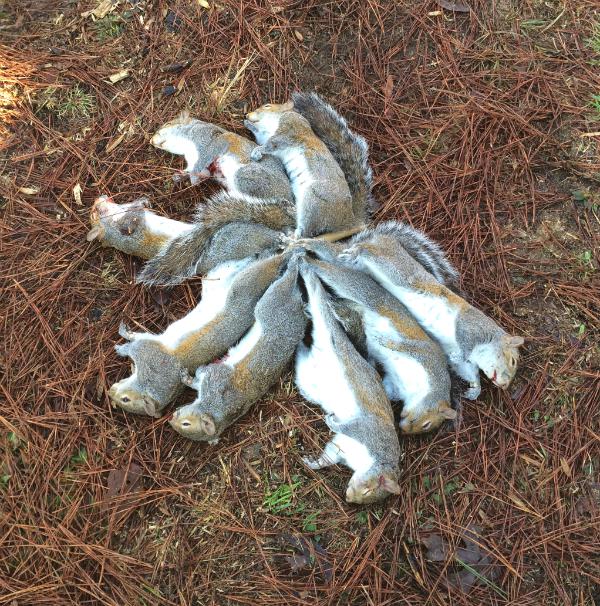
All the squirrels are then field dressed and frozen until I’ve got a batch of 25 to 50 in the freezer. The tails are sent off to Mepps lures for credit towards fishing lures. I’ve got a buddy who takes all the harvested squirrels each season and makes a wicked batch of spicy squirrel Brunswick stew.
While several of the approaches or ideas that I’ve listed above are helpful in keeping squirrels off a deer feeder, I find that the hunting and harvesting of squirrels around the feeder at the end or before each deer season to be the most effective method I’ve tried so far.
Obviously, your own mileage may vary with each suggestion above.
FAQS
Here are some frequently asked questions that I see regarding keeping squirrels out of a deer feeder:
Is there a way to make a deer feeder completely squirrel proof?
Honestly, I don’t think there’s a way to make a deer feeder completely and utterly squirrel proof. And by that, I mean keep every squirrel out of a deer feeder or from eating the deer feed off the ground. I think your best bet is to take stesps to limit their access to the feeder ports and limit how much feed they eat once it’s been dispensed from the feeder.
Does the deer feeder varmint zapper really work?
The Varmint Zapper is an effective solution if hooked up properly and used with a compatible American Hunter Feeder Kit. As I mentioned above, it does put a drain on the feeder battery, but it will keep squirrels and raccoons from climbing up the feeder legs or trying to get through the varmint cage guard.
What’s the best varmint proof deer feeder?
I’m not sure that there’s a single deer feeder model on the market that is totally varmint proof. Several higher-end brands like Boss Buck are built to deter varmints, but they don’t stop the squirrels, rabbits, hogs, etc., from eating the deer feeds off the ground once it’s been dispensed.
Because of those factors, I think it takes a combination of tools and steps from the hunter to make a deer feeder as varmint proof as possible.








